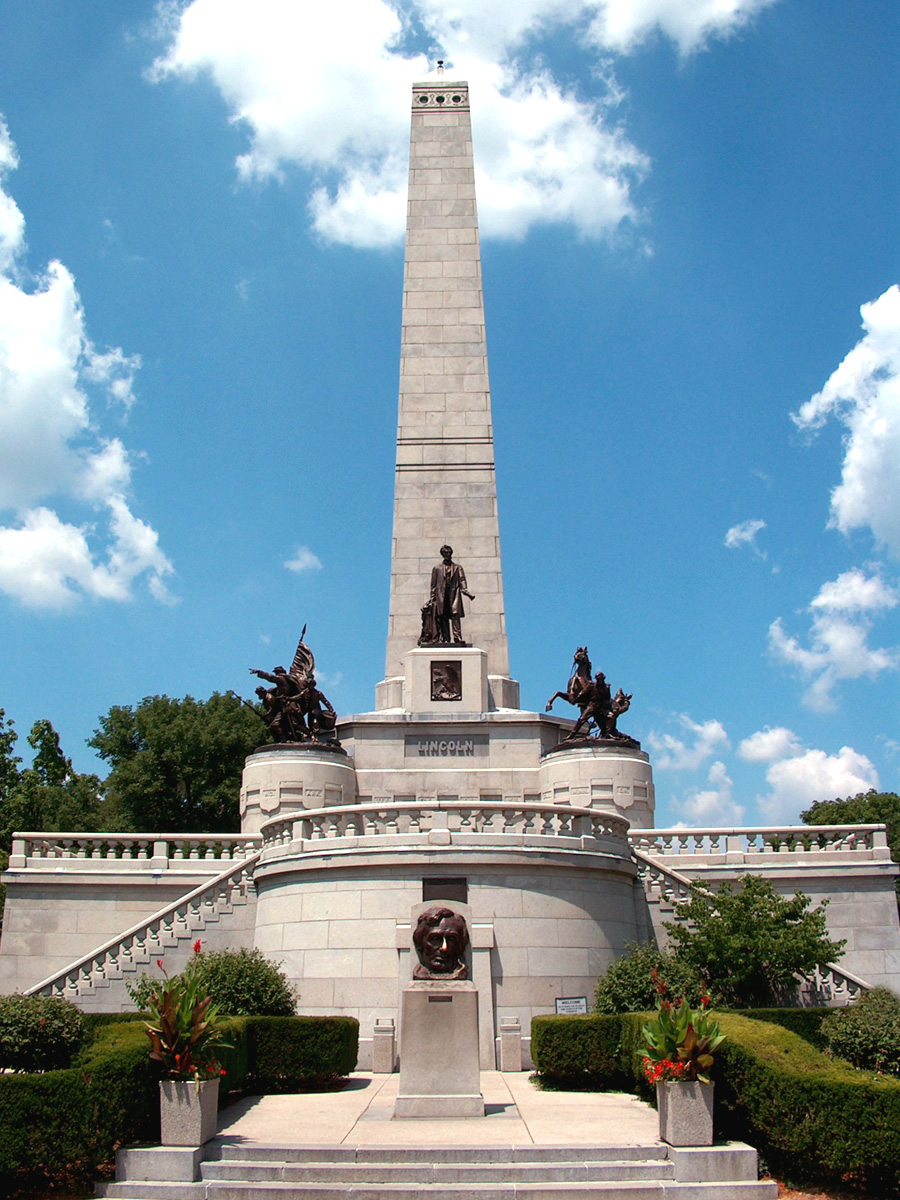
Lincoln Tomb
The Lincoln Tomb is the final resting place of Abraham Lincoln, the 16th president of the United States; his wife Mary Todd Lincoln; and three of their four sons: Edward, William, and Thomas. It is located in Oak Ridge Cemetery in Springfield, Illinois.
Constructed of granite, the tomb has a tall, story-and-a-half base in trapezoidal form, surmounted by an obelisk, with a semicircular receiving room entranceway on one end and a semicircular crypt or burial room opposite. On the exterior, four flights of balustraded stairs lead to a level terrace. The balustrade extends around the terrace to form a parapet, and there are several bronze statues, reliefs, and stone carvings located at the base of the obelisk. The obelisk rises 117 feet (36m) high.
A bronze recasting of Gutzon Borglum's head of Lincoln stands on a pedestal in front of the entrance way; Borglum's original marble bust is in the U.S. Capitol. Inside the tomb's ground level entrance is a rotunda with connecting hallways to the burial room. Marble is used throughout the interior, and several well-known, specially cast bronze statues of Lincoln are displayed in the entrance room and hallways. A stained glass window and flags adorn the crypt, which is centered around an inscribed red marble monument .
At the close of the ceremonies and events marking Lincoln's death, his body was placed in a nearby receiving tomb and later in the state tomb. The mausoleum is owned and administered by the State of Illinois as Lincoln Tomb State Historic Site. It was designated one of the first National Historic Landmarks in 1960, and thus became one of the first sites listed on the National Register of Historic Places in 1966, when that designation was created.
History[edit]
On April 16, 1865, two days after President Abraham Lincoln was assassinated, a group of Springfield citizens formed the National Lincoln Monument Association and spearheaded a drive for funds to construct a memorial or tomb.[3] Upon arrival of the funeral train on May 3, Lincoln lay in state in the Illinois State Capitol for one night.[4] After funeral and burial services the next day, his coffin was placed in a receiving vault at Oak Ridge Cemetery, the site Mrs. Lincoln requested for burial.[3] In December, her husband's remains were removed to a temporary vault not far from the proposed memorial site. In 1871, three years after laborers had begun constructing the tomb, the body of Lincoln and those of the three youngest of his sons were placed in crypts in the unfinished structure.[4]
In 1874, upon completion of the memorial, which had been designed by Larkin Goldsmith Mead, Lincoln's remains were interred in a marble sarcophagus in the center of a chamber known as the "catacombs," or burial room.[3] In 1876, however, after two Chicago criminals failed in an attempt to steal Lincoln's body and hold it for ransom, the National Lincoln Monument Association hid it in another part of the memorial, first under wood and other debris and then buried in the ground within the tomb. When Mrs. Lincoln died in 1882, her remains were placed with those of Lincoln, but in 1887 both bodies were reburied in a brick vault beneath the floor of the burial room.[4]
By 1895, the year the State acquired the memorial, it had fallen into disrepair. During a rebuilding and restoration program from 1899 to 1901, all five caskets were moved to a nearby subterranean vault.[3] Following completion of the restoration, State officials returned them to the burial room and placed that of Lincoln in the sarcophagus it had occupied in 1874–76. Within a few months, however, at the request of Robert Todd Lincoln,[4] the President's only surviving son, Lincoln's remains were moved to their final resting place – a concrete vault 10 feet (3.0 m) below the surface of the burial room. In 1930–31 the State reconstructed the interior of the memorial in an Art Deco style. Rededicated in the later year by President Herbert Hoover, it has undergone little change since that time.[3] The Lincoln Tomb was designated a National Historic Landmark in 1960.
Also part of the site overseen by the State of Illinois, and a short distance from the tomb, three war memorials have been erected: